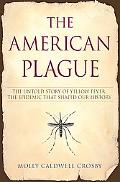

 |

|

The average rating for American Plague The Untold Story of Yellow Fever, the Epidemic That Shaped Our History based on 2 reviews is 2.5 stars.
Review # 1 was written on 2008-12-04 00:00:00 Jennifer Lamonica Jennifer LamonicaThis book was interesting from an historical perspective, though it's descriptions were often needlessly hyperbolic, a flaw shared by many books that tackle infection--as if the authors are worried that if they don't remind us that "the victim became a palate of hideous color," for example, or that "the family mansion had now become a tomb," we will get bored with the science and history and go away. I don't regret reading this book, but I gave it a very low rating because of the extremely poor job that the author does in explaining the science behind the epidemic. One of many examples: A virus is one of the smallest beings in evolution's survival of the fittest, mutating and coalescing in order to thrive, its ultimate goal being epidemic. To begin with, there are problems with the phrase survival of the fittest, as it is commonly interpreted by the lay reader to mean survival of the strongest, which is not what Darwin intended at all. "Fittest" in this context actually means the organism best adapted to its environment will survive to reproduce. Most evolutionary biologists these days stay away from that phrase because of its erroneous implications. Coalescing has no scientific meaning, and just feeds nicely into the "ultimate goal" phrase, which is, of course, ridiculous, as viruses do not have goals. This kind of writing is irresponsible, sows confusion, and reflects poorly on Crosby. She goes on to reveal more incompetence, which frankly I find utterly staggering, as this is supposed to be a book about a virus(!!): It is uncertain whether viruses evolved from a single cell, becoming more complex, or whether they devolved into something simpler, more efficient, gracefully infectious. Though I do love the phrase "gracefully infectious," this passage makes it sound as if viruses are multicellular (specifically "Evolved from a single cell, becoming more complex"). If viruses evolved from the bottom up, as it were, they would likely be evolving from naked RNA. The text is peppered with other scientific inaccuracies, some flagrant, some more subtle, but far far too many to detail here. I found them to be irritating and to constantly remind me of the poor quality of this text. I am curious if a very knowledgeable historian would find this work similarly peppered with errors and distortions for dramatic effect. If you would like to read an excellent historical and scientific account of an epidemic, I would recommend Steven Johnson's The Ghost Map . Or Barry's The Great Influenza. |
Review # 2 was written on 2016-01-06 00:00:00 Sharon Griffin Sharon GriffinIt begins with a piercing headache. Movement becomes painful and the skin burns. Fever rises to 104 or 105. The kidneys stop functioning, and abdominal cramps begin. In the final days due to internal hemorrhaging, the patient vomits black blood. The skin and eyes become bright yellow. These are the terrifying effects of yellow fever, a disease that struck fear like no other among Americans. For over 200 years yellow fever would claim 100,000 deaths in the U.S. and shape the history of the country. In fact, the U.S. capital was moved to Washington, D.C. after an epidemic in Philadelphia in 1793. The first third of The American Plague, my favorite part, discusses the devastation of the 1878 epidemic in Memphis. While the city celebrated its extravagant Mardi Gras celebration, it was oblivious to the fact that in a few months a ship would leave Cuba transporting sugar and death. All of the elements were in place for an outbreak- a mild winter, poor sanitation and drainage, and new immigrants with no previous exposure to the disease. In July the Emily B. Souder made its way up the Mississippi River with infected crew aboard. When the outbreak began in August, so began a mass exodus. 25,000 people fled the city within five days. In July before the outbreak, the population had been around 47,000. By September 19,000 people remained and 17,000 of those had yellow fever. By December it was over. 5,000 had perished in Memphis, and 20,000 total died in the Mississippi Delta. The descriptions of the city during those months is horrific. This epidemic changed the demographic landscape of a burgeoning city and the course of its future. The remainder of the book focuses on the studies in Cuba by Walter Reed and his team to find the source and means of transmission of yellow fever. Ultimately, it is determined that the disease is spread by a vector, a mosquito. This part of the book was interesting because I was unaware of Walter Reed's contribution to medicine. It was surprising to read about medicine in the U.S. at the turn of the century because it was truly in its infancy. I would recommend this book to anyone who enjoys history and medical research. I found it engrossing and informative. I would rate it 4.5 because the author meticulously researched the material, even though at times the information was almost overwhelming. |
CAN'T FIND WHAT YOU'RE LOOKING FOR? CLICK HERE!!!